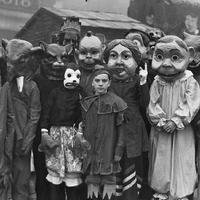Halloween Origins 5 of 8: Parties
Halloween is an annual holiday celebrated each year on October 31, and Halloween 2018 occurs on Wednesday, October 31.
ハロウィン|||||||||||||||
It originated with the ancient Celtic festival of Samhain, when people would light bonfires and wear costumes to ward off ghosts.
Он возник из древнего кельтского праздника Самайн, когда люди зажигали костры и надевали костюмы, чтобы отгонять призраков.
In the eighth century, Pope Gregory III designated November 1 as a time to honor all saints; soon, All Saints Day incorporated some of the traditions of Samhain.
В восьмом веке папа Григорий III назначил 1 ноября временем почитания всех святых; вскоре День всех святых включил некоторые традиции Самайна.
The evening before was known as All Hallows Eve, and later Halloween.
Вечер перед этим был известен как Ночь всех святых, а позже — Хэллоуин.
Over time, Halloween evolved into a day of activities like trick-or-treating, carving jack-o-lanterns, festive gatherings, donning costumes and eating sweet treats.
|||||||||||||||||||zakładania|||||
Halloween Parties: By the 1920s and 1930s, Halloween had become a secular, but community-centered holiday, with parades and town-wide Halloween parties as the featured entertainment.
||||||||||||||ориентированным на сообщество||||||||||||
|||||||||||weltlich|||||||||||||||
|||||||||||świeckie|||||||||||||||
Despite the best efforts of many schools and communities, vandalism began to plague some celebrations in many communities during this time.
|||||||||破坏行为|||||||||||
Trotz||||||||||||plagen||||||||
||||||||||||портить||||||||
Несмотря на старания многих школ и сообществ, варварство начало портить некоторые празднования в многих общинах в это время.
By the 1950s, town leaders had successfully limited vandalism and Halloween had evolved into a holiday directed mainly at the young.
||||лидеры||||||||||||||||
|||||||||||||||||principalmente|||
К 1950-м годам городские лидеры успешно ограничили варварство, и Хэллоуин стал праздником, ориентированным в основном на молодежь.
Due to the high numbers of young children during the fifties baby boom, parties moved from town civic centers into the classroom or home, where they could be more easily accommodated.
|||||||||||||||||гражданских|||||||||||||
||||||||||||||||||||||||||||||untergebracht werden
|||||||||||||||||obywatelskich|||||||||||||zakwaterowane
||||||||||||||||||||||||||||||容纳
Из-за большого количества маленьких детей в период бэби-бума пятидесятых, вечеринки переместились из городских культурных центров в классы или дома, где их было легче организовать.
Between 1920 and 1950, the centuries-old practice of trick-or-treating was also revived.
Trick-or-treating was a relatively inexpensive way for an entire community to share the Halloween celebration.
||||||недорогой||||||||||
Народный праздник Хэллоуина, известный как "Угощение или шалость", был относительно недорогим способом для всего сообщества разделить празднование Хэллоуина.
In theory, families could also prevent tricks being played on them by providing the neighborhood children with small treats.
В теории, семьи также могли предотвратить шалости в свой адрес, предоставляя детям из окрестностей маленькие угощения.
Thus, a new North American tradition was born, and it has continued to grow.
так|||||||||||||
So|||||||||||||
tak|||||||||||||
Таким образом, новая североамериканская традиция была рождена, и она продолжает расти.
Today, people in the US spend an estimated $6 billion annually on Halloween, making it the country's second largest commercial holiday after Christmas.
|||||||||jährlich||||||||||||
Сегодня люди в США ежегодно тратят около 6 миллиардов долларов на Хэллоуин, что делает его вторым по величине коммерческим праздником в стране после Рождества.

